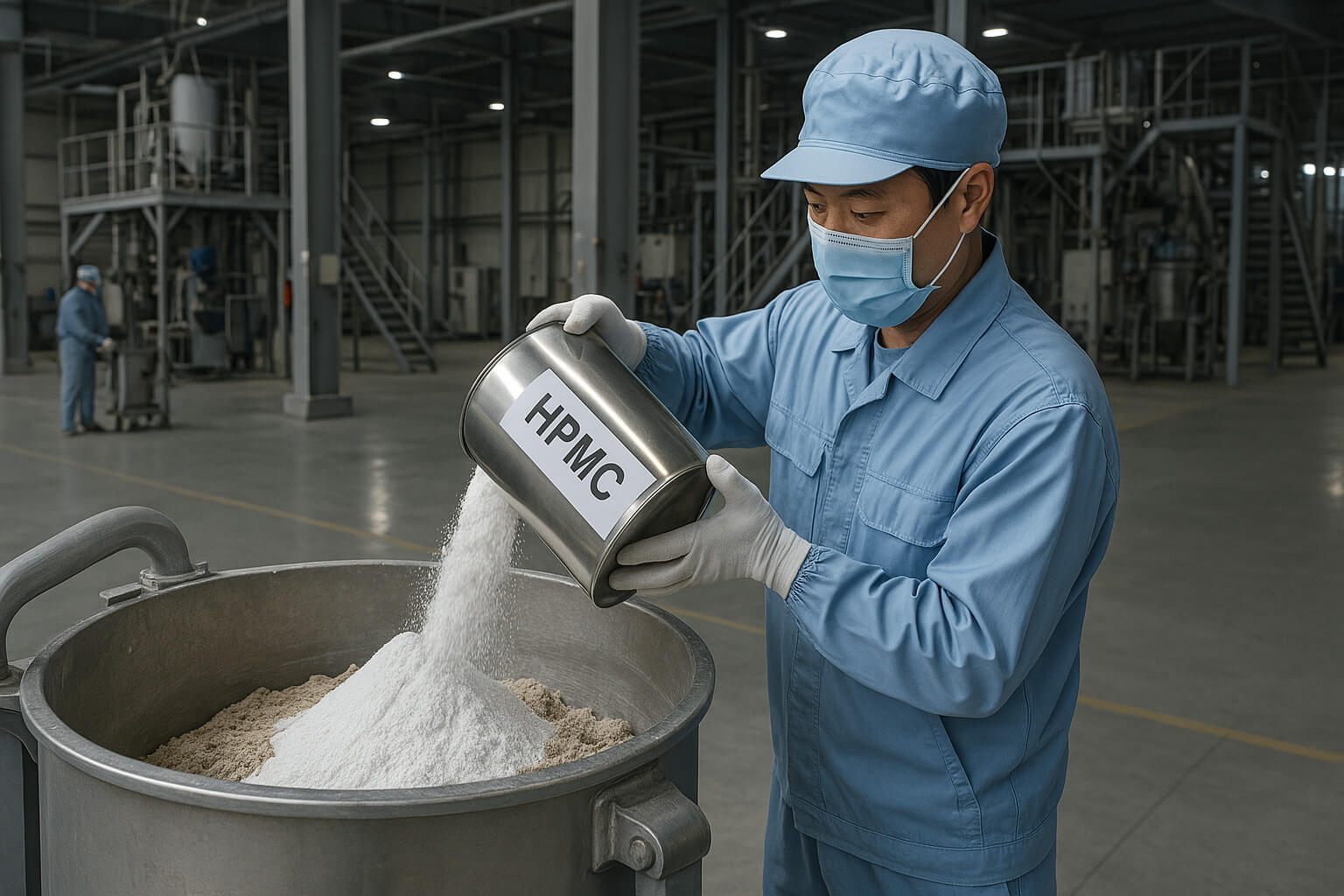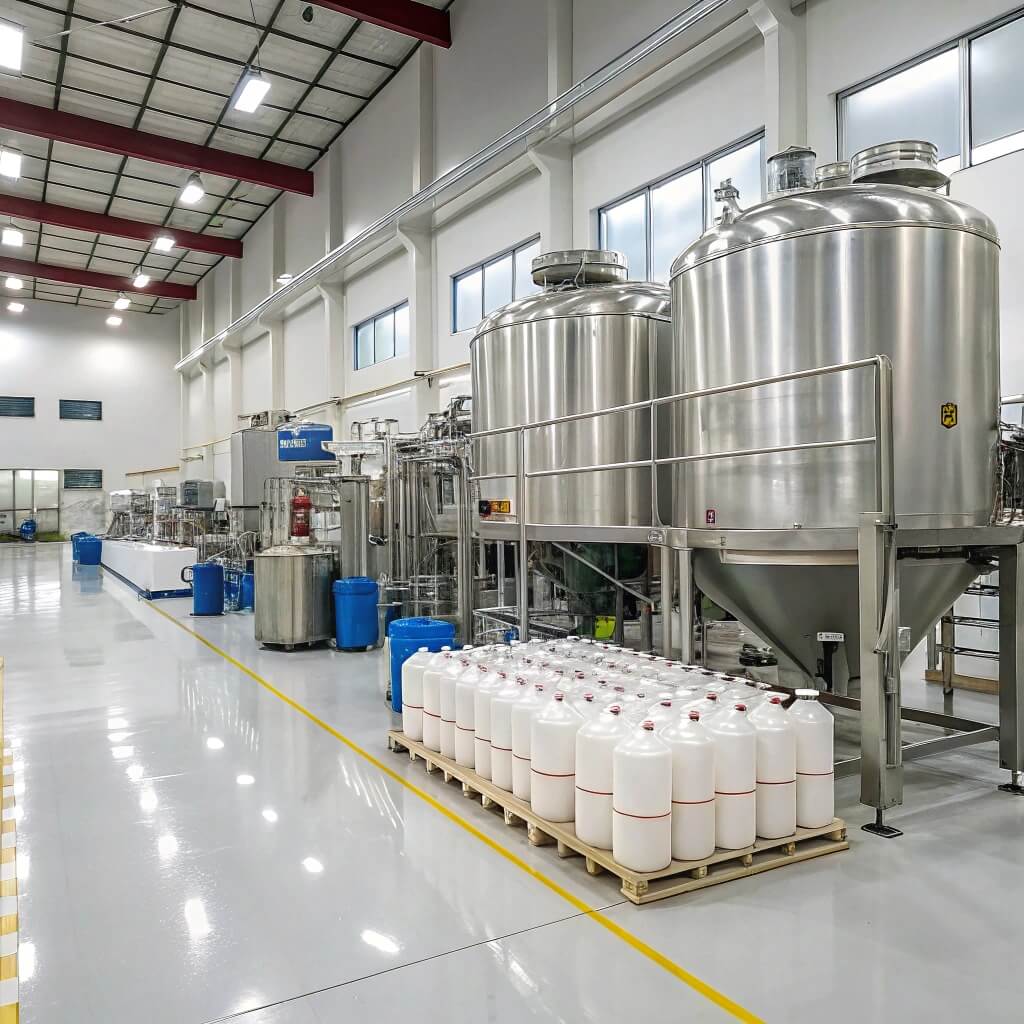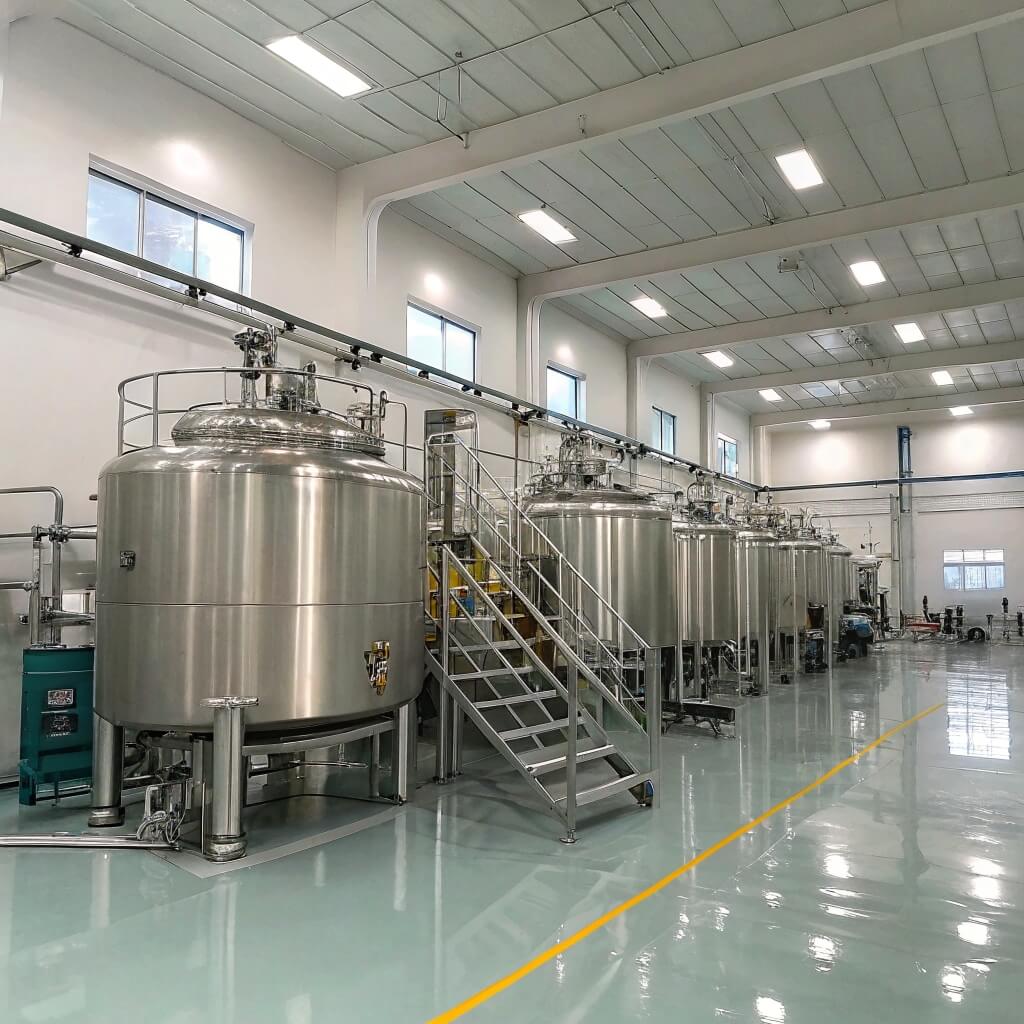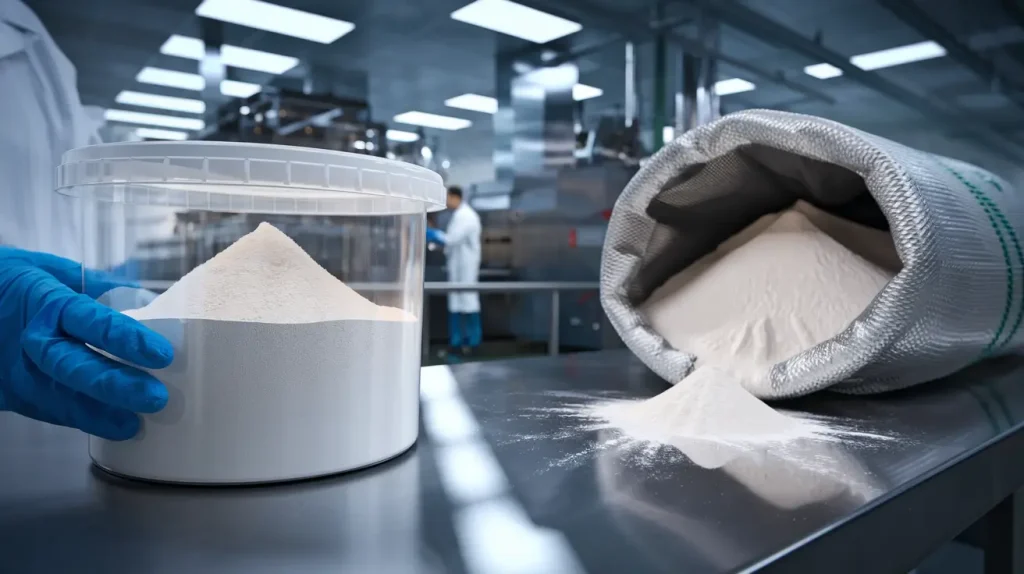Many tile adhesive manufacturers struggle with inconsistent product quality that leads to application failures and customer complaints.
Selecting the right Hydroxypropyl Methylcellulose (HPMC) grade is crucial for tile adhesive performance as it directly affects water retention, open time, sag resistance, and bond strength – key factors determining overall product quality.

Factory worker adding precise amounts of HPMC powder during tile adhesive manufacturing, showing the white powder being mixed into the dry mortar components.
The choice between various HPMC types may seem daunting, but our experience as a leading manufacturer can simplify your selection process.
What is the role of HPMC in tile adhesive?
Tile installers face costly rework when adhesives dry too quickly, preventing proper tile placement and adjustment.
HPMC serves as a critical water-retaining agent in tile adhesives, extending open time while improving workability, adhesion strength, and sag resistance – ultimately determining whether tiles stay firmly attached or fail prematurely.
At our production facility, we've observed how HPMC transforms ordinary cement mixtures into high-performance tile adhesives. The cellulose ether creates a molecular network that controls water movement within the adhesive matrix. This network slows water evaporation and prevents excessive absorption into porous substrates like concrete or gypsum boards. Without sufficient HPMC, water leaves the system too quickly, causing incomplete cement hydration and poor bonding.
HPMC also acts as a thickening agent, adding lubricity that makes the adhesive more workable and easier to apply. The polymer chains increase viscosity in the fresh mortar, allowing for smooth troweling while preventing tiles from slipping during installation. This thixotropic behavior explains why properly formulated adhesives maintain ridge structure yet spread easily under pressure.
From years of product testing, we've confirmed that HPMC significantly affects the final mechanical properties of cured adhesives. The correct grade and dosage ensure optimal balance between flow properties during application and structural integrity after curing. Modern tile adhesives, especially for large format tiles or vertical applications, rely heavily on precisely engineered HPMC characteristics.
How do different HPMC grades affect tile adhesive performance?
When adhesive fails mid-installation, contractors lose time, materials, and reputation due to inappropriate HPMC selection.
Different HPMC grades primarily affect tile adhesive through viscosity, methoxyl content, hydroxypropyl substitution, and particle size – each parameter influencing critical performance aspects from workability to final strength.
Our testing laboratory has extensively analyzed how HPMC specifications translate to real-world adhesive performance. Viscosity, measured in mPa·s, directly impacts water retention capability and sag resistance. Higher viscosity grades (30,000-100,000 mPa·s) excel in preventing vertical slippage for wall applications, while medium viscosity types (15,000-30,000 mPa·s) offer better workability for floor installations. Lower viscosity grades often result in insufficient water retention and premature adhesive skinning.
Methoxyl content, typically ranging from 19-30%, affects water solubility and cement compatibility. Our production data shows that HPMC with 28-30% methoxyl content provides optimal cement compatibility for tile adhesives, allowing for proper setting time without excessive retardation. The hydroxypropyl substitution level influences flexibility and adhesion to non-porous tiles, with 7-12% substitution showing the best balance for most applications.
Particle size distribution significantly impacts dissolution rate and lump formation during mixing. Through multiple batch analyses, we've determined that 100-mesh HPMC with controlled particle size distribution minimizes mixing time while preventing the formation of undissolved "fish eyes" that can compromise adhesive performance. For rapid-setting formulations, specially treated grades with delayed dissolution provide better working time management.
HPMC Grade Performance Comparison for Tile Adhesives
| Proprietà | Low Viscosity HPMC (5,000-15,000 mPa·s) | Medium Viscosity HPMC (15,000-40,000 mPa·s) | High Viscosity HPMC (40,000-100,000 mPa·s) |
|---|---|---|---|
| Ritenzione idrica | Moderare | Bene | Eccellente |
| Orario di apertura | 10-15 minutes | 20-30 minutes | 30+ minutes |
| Resistenza al cedimento | Poor to Fair | Bene | Eccellente |
| Lavorabilità | Eccellente | Bene | Fair |
| Best Application | Economy thin-set | General purpose | Large format tiles & walls |
Our production experience confirms that medium viscosity HPMC grades with 28% methoxyl content and 8-10% hydroxypropyl substitution represent the most versatile choice for standard tile adhesives. For specialized applications, such as large-format wall tiles or rapid-setting formulations, the selection criteria must be more specific to the performance requirements.
What factors should guide your choice of HPMC for tile adhesive?
Production managers waste significant resources on trial-and-error testing when they lack clear selection criteria for HPMC.
Your HPMC selection should be guided by application environment, tile porosity, format size, setting time requirements, and cost considerations – each factor narrowing down the optimal grade for your specific adhesive formulation.
After supplying HPMC to global tile adhesive manufacturers for over a decade, we've identified key decision factors that consistently deliver successful results. The application environment significantly impacts which HPMC properties matter most. For bathroom and wet area installations, higher water retention becomes critical to prevent premature drying, while outdoor or high-temperature environments require HPMC with superior cement hydration control.
Tile characteristics profoundly influence HPMC selection. Non-porous tiles like porcelain require HPMC grades with extended open time to compensate for reduced water absorption. Large format tiles benefit from higher viscosity HPMC that provides excellent sag resistance and adjustability. Natural stone may need specialized grades that minimize water-soluble components to prevent staining.
From our manufacturing perspective, we've seen how setting time requirements affect HPMC choices. Fast-track construction projects often need rapid-setting formulations with specialized HPMC that provides initial water retention but doesn't excessively delay cement hydration. Conversely, complex installation patterns benefit from HPMC grades offering maximum open time and adjustability.
Production cost considerations must balance performance needs against budget constraints. Based on actual production data, we've found that medium-viscosity HPMC with balanced substitution levels typically offers the most cost-effective solution for general-purpose tile adhesives. For economy products, lower viscosity grades can be supplemented with other additives, while premium formulations often justify higher-cost specialty grades with enhanced performance.
Regulatory requirements have also become increasingly important in HPMC selection. Our technical team ensures all products meet global standards for construction chemicals, including low VOC requirements and sustainable manufacturing practices.
How to interpret technical data when selecting tile adhesive HPMC?
Misunderstanding technical specifications often leads to selecting unsuitable HPMC types that compromise adhesive quality and increase material waste.
The key parameters to evaluate in HPMC technical datasheets include viscosity ranges, substitution degree percentages, particle size distribution, moisture content, and gel temperature – all directly affecting your adhesive's performance.
Our laboratory routinely analyzes how these technical specifications translate to real-world adhesive behavior. When reviewing viscosity data, remember that values are typically measured in 2% solution at 20°C. Small viscosity variations (±10%) generally don't significantly impact performance, but variations beyond this range can affect water retention and sag resistance. According to industry research on cellulose ethers, viscosity measured in standardized conditions correlates strongly with water retention capability.
Substitution degree requires careful interpretation. Methoxyl content (typically 19-30%) affects water solubility and cement interaction. Higher methoxyl content generally means better cement compatibility but potentially reduced water solubility. Hydroxypropyl content (7-12% typical range) influences flexibility and adhesion. Our testing shows that a balanced ratio between these substitutions delivers optimal performance for most tile adhesives.
Particle size distribution directly impacts dissolution behavior. Technical data usually specifies the percentage passing through standard mesh sizes (e.g., 80 mesh, 100 mesh). In our production experience, uniformity of particle size matters as much as the absolute value. Non-uniform distribution can cause unpredictable dissolution rates and "fish eye" formation during mixing.
Gel temperature indicates the temperature at which the HPMC solution transitions from liquid to gel state. Lower gel temperatures (30-45°C) help prevent adhesive skinning in warm conditions. This specification becomes particularly important for applications in hot climates or when working under direct sunlight, as noted in thermal stability studies from construction material testing institutes.
Moisture content, typically specified as <5%, affects shelf life and handling properties. Our quality control data demonstrates that even small variations in moisture can influence dissolution behavior and ultimately affect adhesive performance consistency.
What are the common application dosages and mixing techniques?
Improper HPMC dosage or mixing sequence creates costly quality issues including poor workability, weak bonding, and excessive material consumption.
Optimal HPMC dosage typically ranges from 0.2% to 0.5% of total dry mix weight, with specific mixing protocols requiring pre-dispersal or specialized equipment to prevent lumping and ensure complete activation.
From our production experience, we've established reliable dosage guidelines for different tile adhesive types. Economy-grade thin-set mortars generally require 0.15-0.25% HPMC by weight, while standard-grade adhesives perform best with 0.25-0.35%. Premium and specialized formulations, including those for glass mosaics or large-format tiles, often need 0.35-0.5% dosage to achieve the required performance characteristics.
The mixing sequence significantly impacts HPMC activation and functionality. In industrial production, we recommend dry blending HPMC with cement and aggregates before water addition. This approach ensures uniform distribution throughout the mixture. However, in smaller operations or for specialized products, a "pre-dispersal" technique may be beneficial. This involves creating a slurry of HPMC in cool water (below 10°C) before adding to other ingredients, helping prevent lumping in high-viscosity grades.
Mixing equipment selection affects HPMC performance. High-shear mixers generally produce more consistent results than paddle mixers by breaking up agglomerates and ensuring complete dissolution. For large-scale operations, our technical team has observed that continuous mixers with controlled residence time provide the most consistent results when properly calibrated.
Mixing duration requires careful optimization. Insufficient mixing leads to undissolved HPMC and inconsistent performance, while excessive mixing can damage the cellulose ether structure through mechanical shearing. Based on our manufacturing data, optimal mixing typically requires 3-5 minutes after water addition in high-shear equipment, or 7-10 minutes in conventional mixers. Mixing temperature should be controlled between 15-25°C for best results, as higher temperatures can trigger premature gelation of certain HPMC grades.
Storage conditions of the final mixed adhesive also influence performance. Products containing HPMC should be protected from high temperatures and direct sunlight to prevent premature skinning. According to building material storage guidelines, adhesives with HPMC perform best when used within the temperature range specified by the manufacturer.
How does Morton HPMC compare with competitors in tile adhesive applications?
Manufacturing with inconsistent HPMC creates unpredictable open times and bond strengths, leading to application failures and damaged business relationships.
Morton HPMC delivers superior consistency across production batches, targeted dissolution rates, and enhanced water retention profiles compared to average market offerings – resulting in more reliable tile adhesive performance.
Our manufacturing facility ensures quality consistency through rigorous testing of every production batch. Unlike some suppliers who test composite samples, we perform full parameter analysis on each batch, including viscosity, substitution degree, particle size distribution, and gel temperature. This approach has resulted in batch-to-batch viscosity variation of less than ±5%, compared to industry averages of ±10-15%. For tile adhesive manufacturers, this translates to consistent water retention and open time performance without needing constant formula adjustments.
Through specialized production technology, we've developed HPMC grades with controlled dissolution profiles specifically engineered for tile adhesive applications. Our standard construction grade offers balanced dissolution that prevents both "fish eyes" and premature water absorption. For fast-setting formulations, our surface-treated HPMC provides delayed dissolution that prevents skinning while maintaining excellent late-stage water retention.
Comparative testing against major market alternatives shows that Morton HPMC delivers superior water retention under standardized conditions. In tests following European Standard EN 12808 methodologies, our medium-viscosity grade retained 98% of mix water after 30 minutes, compared to the 92-95% range typical of competing products. This translates to approximately 20-30% longer open time in real-world applications.
Our technical support differentiates Morton HPMC in the market. Rather than providing generic recommendations, our application specialists work directly with customers to develop custom specifications based on their specific equipment, formulations, and performance targets. This collaborative approach has helped customers reduce HPMC usage by 5-15% while maintaining or improving performance, resulting in significant cost savings.
Quality control testing for all Morton HPMC includes application evaluation in standardized tile adhesive formulations. This means our products are validated in actual end-use conditions, not just for chemical specifications. According to customer feedback collected through our satisfaction surveys, this application-focused approach has reduced formulation troubleshooting time by an average of 40%.
Domande frequenti
What are the primary uses of different HPMC grades in construction?
HPMC grades serve specific functions across construction applications based on their viscosity and substitution levels. Low-viscosity grades (5,000-15,000 mPa·s) work well in self-leveling compounds and grouts. Medium-viscosity types (15,000-40,000 mPa·s) excel in standard tile adhesives and renders. High-viscosity grades (40,000-100,000 mPa·s) perform best in wall putties, heavy-duty adhesives, and specialized mortars requiring maximum water retention.
What adhesive do professional tilers typically use?
Professional tilers predominantly use modified cementitious adhesives containing HPMC and polymer additives. These adhesives typically meet C2 classification (improved cementitious adhesive) under ISO 13007 standards, offering superior bond strength and flexibility. For challenging installations like facades or heavy tiles, professionals choose S1 or S2 classified products with enhanced deformability. Epoxy adhesives serve special applications requiring chemical resistance.
What is the strongest adhesive for ceramic tiles?
Epoxy-based tile adhesives provide maximum bond strength (>2.5 N/mm²) and are virtually waterproof, making them ideal for demanding environments. However, modified cementitious adhesives with HPMC and high polymer content offer excellent strength (1.5-2.0 N/mm²) with better workability and cost-effectiveness. The strength requirement should match specific project needs, as excessive strength can actually cause installation issues when adjustments are needed.
What are the essential raw materials in tile adhesive manufacturing?
Tile adhesives typically comprise 25-35% cement (Portland or white), 60-70% graded silica sand or limestone, 0.2-0.5% HPMC for water retention, 2-5% redispersible polymer powder for flexibility and adhesion, and 0.1-0.3% other additives including retarders, accelerators, and wetting agents. Premium formulations may include additional components like glass fibers for reinforcement or lightweight fillers for improved workability and reduced weight.
Conclusione
Selecting the right HPMC grade substantially impacts your tile adhesive quality, affecting everything from production efficiency to end-user satisfaction. Through our experience manufacturing 30,000 tons of HPMC annually, we've observed how proper grade selection directly correlates with reduced customer complaints and increased product reputation.
The optimal choice depends on your specific requirements – standard installations generally benefit from medium-viscosity grades (20,000-30,000 mPa·s), while specialized applications may require precisely engineered alternatives. Consider not just viscosity but also substitution degree, particle size, and dissolution profile when making your selection.
For manufacturers seeking consistent performance and technical support, our team can provide customized HPMC samples tailored to your exact formulation needs. Contact Morton today to discuss your specific tile adhesive challenges and discover how our HPMC solutions can enhance your product performance.




